also began recently to make its famous Ektachrome 100 available in 120 and 4x5 formats: the 35mm film had arrived in 2018. While I bought the CatLABS and KosmoFoto film directly from the manufacturers in the USA and UK respectively, much of my film comes from CameraFilmPhoto in Hong Kong, whose prices and quick delivery times to my office are suitable for me.
I have tried several Ilford films from this source and prefer Pan F (ISO 50) and SFX 200. I also like the Bergger Pancro 400 film. Ortho 80 is currently shown as Out of Stock. More recently I have also noticed that a couple of camera stores in high end malls have begun to stock limited quantities of film, when their camera stock is entirely digital. One even had a couple of the Ilford Harman disposable and reusable 35mm camera from Harman.
Harman reusable camera (left) and disposable camera
This month (January 2020), FILM Ferrania's P30 (35mm)black-and-white film has been made available to several film retailers across Europe (KosmoFoto). Several other film brands are available online (Adox, DerevPan, Fujipan, Lomography, Rollei, Svema, Silberra, and more). While some of these brands may have low sales, or could be considered specialist, the idea that they still exist and that new films are being released confirms the renewed popularity of the medium.
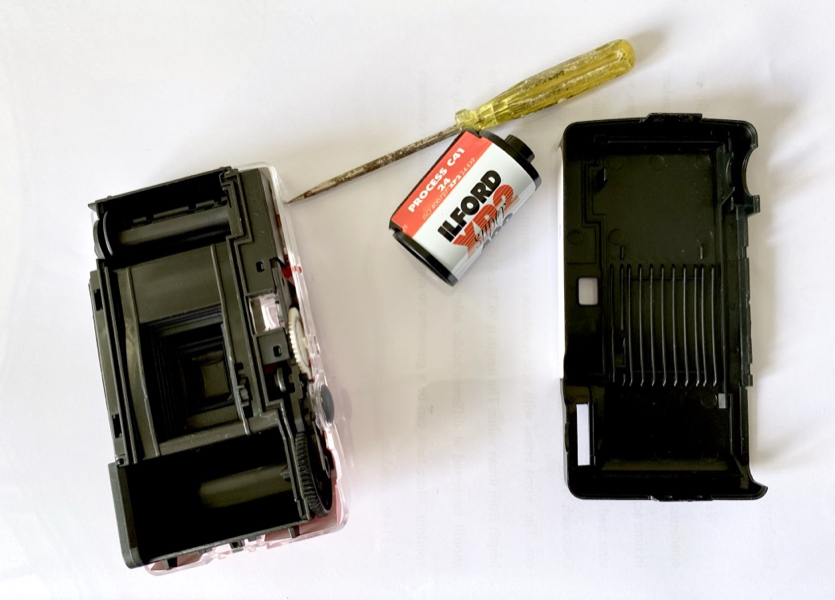
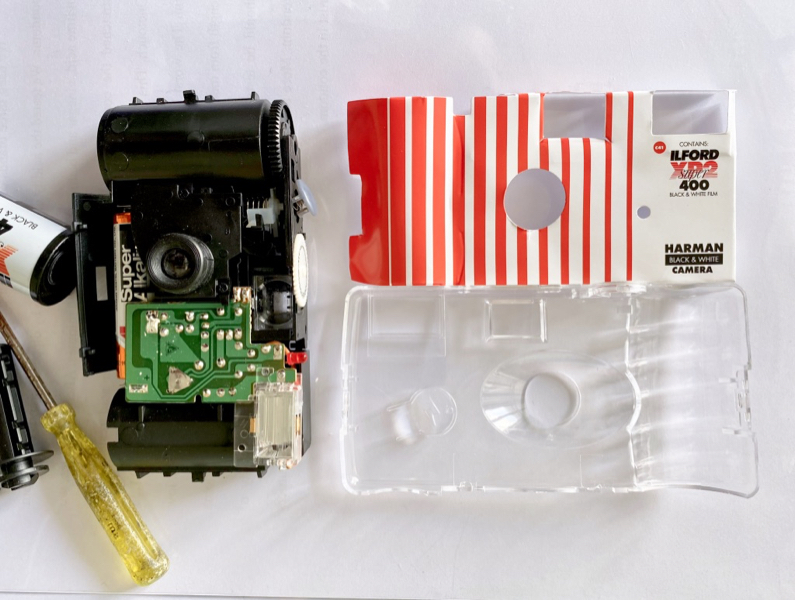
Harmon disposable camera, disassembled after use, showing circuitry inside
Film in Cameras
The cameras are all manual, although some, like my Nikon FM2 and the Mamiya 1000DTL, do have in-camera metering. For most I use a metering app on the iPhone (Pocket Light Meter). Output size from the Hasselblad and a couple of bellows cameras is 6x6. The Agfa Record produces 6x9 negatives. The Bronica ETRS produces 645 output (6x4.5). These camera formats take 12, 8 and 15 images using a roll of 120 (medium format) film. There are occasional problems with light leaks or dust, but some editing may clean this up. A 35mm camera takes 36 shots from a roll of film, although rolls of 24 exposures had been available once.
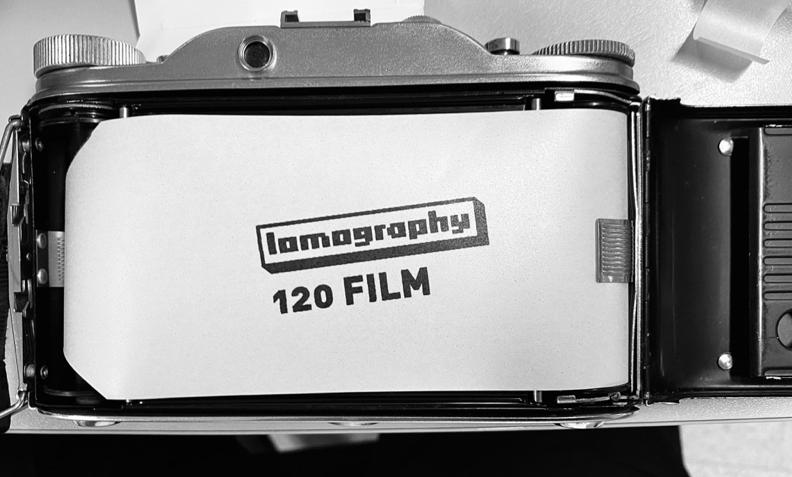
Loading Lomo film into the Agfa Record III
Unlike many photo enthusiasts, I do not develop my own film for a number of practical reasons and use local labs. Processing time for color is usually a few hours, but black and white film takes about a week. I prefer to scan my own negatives as part of my creative process - seeing the images appear on the screen for the first time helps me make decisions about editing. The scanning has also helped me make strategic decisions about film types, brands and about cameras.
The Ilford and KosmoFoto films have slightly thicker plastic backing and the negatives stay flat in the scanner. Other films may not. Bergger used to be one of the films that laid flat, but a few recent rolls have curled making scanning slightly less easy, although the results from this film (and CatLABS80) make them worth the slight effort involved. I also find it less easy to handle 35mm film with the flatbed scanner film-holder, although this is something of a subjective judgement.
When I re-discovered film, I bought a Canon 9000 MkIII flatbed scanner, but did not install the proprietary software. My experience with Canon printer drivers was not good. When Apple updated its OS, the printer might not work until a new driver was released and updates for users in Thailand were later than for other countries. Instead I downloaded Hamrick's ViewScan which has never let me down. There was a ViewScan for iOS, but this only supported WiFi (all-in-one) scanners and is no longer under development. A Mac or PC is needed for scanning. As with DSLR tethering, the iPad Pro is not as much a Pro device as we might like. Although the shops I use for film developing provide a scanning service, I prefer to roll my own.
Canon 9000 III flatbed scanner with film holders for 120 and 35mm film (right)
As with my DSLR images, I save all files on external media, which allows me to keep only those images I want in Photos. This is an attempt to save space in Photos and iCloud, but with almost 18,000 images, I need to cull more. I scan all images with a small margin, so I need to crop those images I keep. The margin also gives me some flexibility when straightening a photograph. Although black and white images do not need saturation, other editing tools are needed to bring out the best in a similar way to DSLR photographs and RAW pictures taken with the iPhone.
One of the reasons I now concentrate on medium format photography is the size compared to 35mm. The frame size of 35mm is 36 x 24 mm (aspect ratio 3:2), giving an area of 864 sq. mm. In comparison, medium format (120) film from the Hasselblad is about 61 x 61 giving an image area of 3721 sq. mm. The other formats I use are 6 x 9 and 645: about 56 x 84 (4704 sq. mm) and 60 x 45 (2700 sq. mm) respectively. Compared to 35mm film, each frame of 120 has far more information recorded so (in theory) the quality is higher.
Older cameras and their lenses may not produce output that is as reliable as that from a DSLR, leaving aside the user-errors that occur with any photography. Light leaks, exposure, focus are common problems, along with dust (camera, developing, scanning). Once an image is scanned, it can usually be improved by sensible editing. As with the other sections (on Smartphones and DSLR), I have several apps that can be used for editing. I edit on the device I am using at the time, depending on any specific tools I may need. Apple Photos, particularly has mismatched tools and (now) a different interface on Macs and iOS.
Cropping is an essential task as well as straightening. Apple Photos on iOS devices has new tools for adjusting perspective and keystone. Despite Photos on the Mac having a richer toolset, these useful extras are not available. I am also disappointed that the new versions of Photos do not have B&W adjustments (and Tone). However, with the other apps, the image can be enhanced from the original scanned artifact.
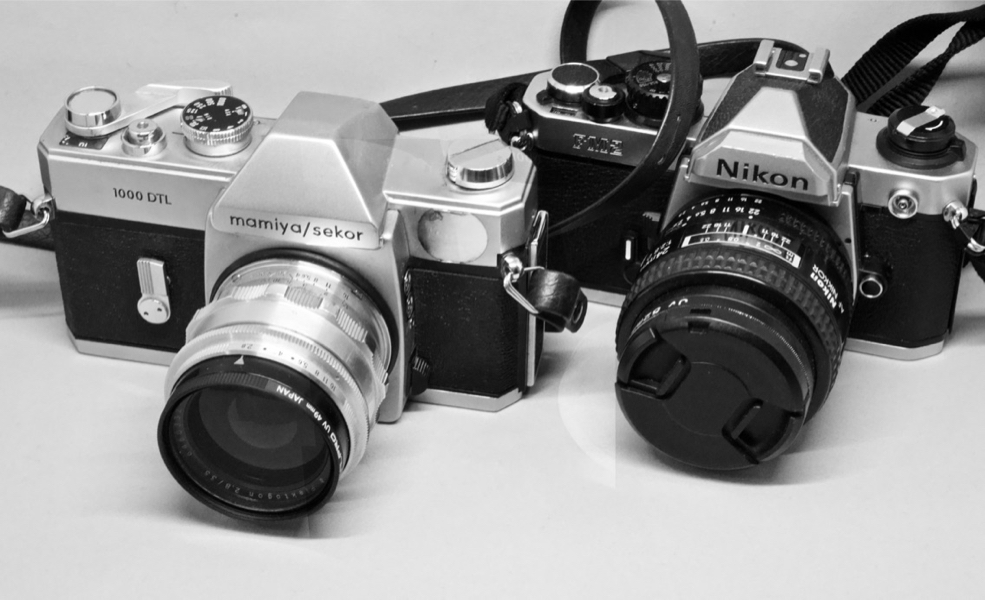
Mamiya 1000 DTL (let) and Nikon FM2
End Notes
For the long term, using a film camera, especially medium format devices, has made me look at the scene more carefully. I had already been aware of how to look at a subject when taking a photograph, from the valuable input in 1986 of Tony Harvey (director of The Lion in Winter) one morning in New York, but working again with film made me concentrate even more. I sharpened up some of the skills I had lost from the laziness of digital camera use. Both my smartphone and DSLR output have improved.
I also find that the almost-exclusive use of black and white film makes me look not at color, but at shadows and contrast. Mirrorless cameras with electronic viewfinders can give the user a black and white view of a scene, but my Nikon does not have this capability. However, I can change the LED screen to monochrome so after a photograph is taken it is shown in black and white. I could turn on Live view, but the one-eye-through-the-viewfinder is how I prefer to work: arm's length examination of a scene through the LED screen wastes time.
As I work more on film, so my approach to digital photography benefits. Film too allows the photographer to improve both input (light metering) and output with the scanning and later editing. It would be possible to work on a photo negative without any digital work. This is how things were done before the arrival of computers, with Ansel Adams techniques (dodge and burn). They way he worked on a negative before printing is now part of photographic lore. Most people these days find it easier to merge the technologies to produce the best digital output from the analogue input. The purpose here is not to separate the media but to indicate how each can benefit from the other.
See also:
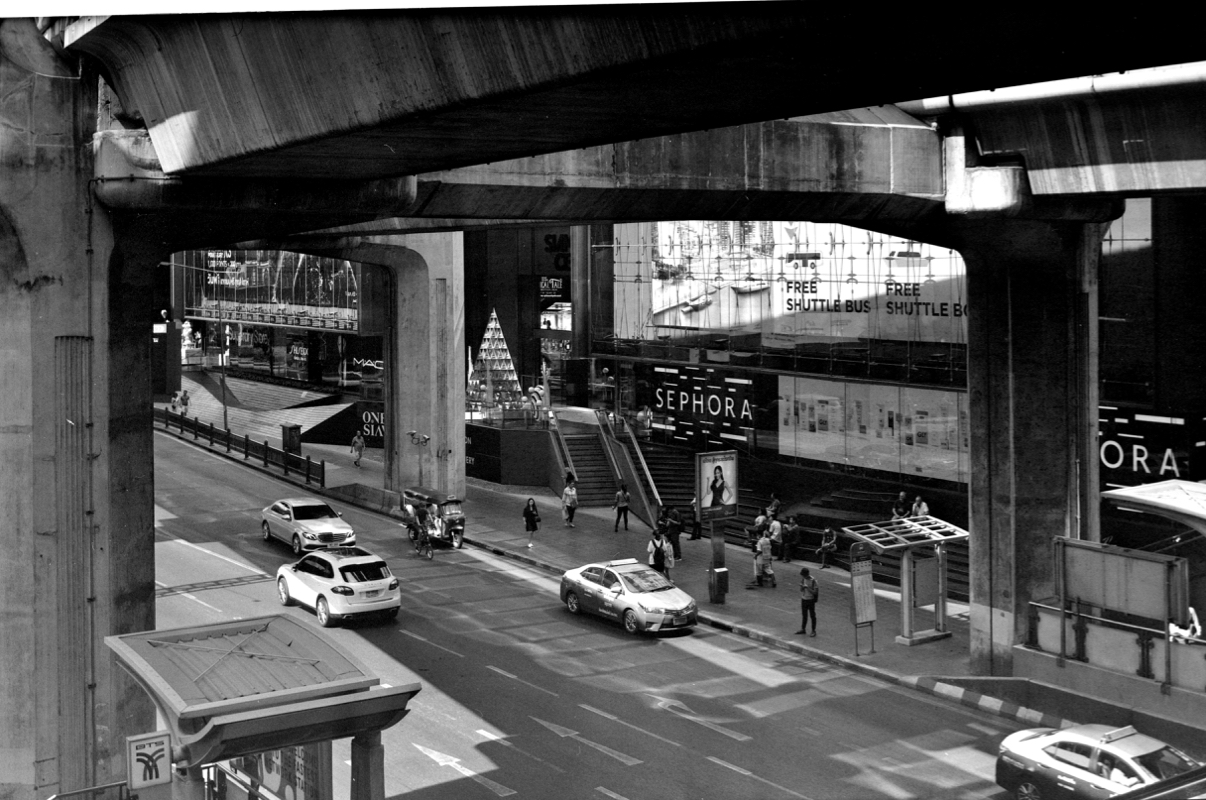
Siam area, central Bangkok - Agfa Record III using Bergger Pancro 400 film
Graham K. Rogers teaches at the Faculty of Engineering, Mahidol University in Thailand. He wrote in the Bangkok Post, Database supplement on IT subjects. For the last seven years of Database he wrote a column on Apple and Macs. After 3 years writing a column in the Life supplement, he is now no longer associated with the Bangkok Post. He can be followed on Twitter (@extensions_th)
